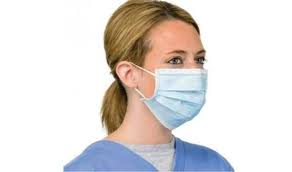2 April 2020
By Mary Bermingham
mary@TheCork.ie

This is called a ‘surgical mask’. It’s the style of mask your dentist typically uses. It’s the cheapest type of mask and typically retails for €2 these days. If you wore this a few weeks ago you would have gotten funny looks on the street, indeed if you wear it today many people will think YOU have the virus and will act cautiously around you, but are we now reaching the point in Ireland where mask-wearing will be normalised?
Many people in Asia routinely wear face masks to stop passing on illnesses to others, or to reduce pollution particles entering their airways, but public use of masks has been less common in Ireland, Europe and the United States where – in general – people have been urged by the Surgeon General to reserve supplies for frontline medical staff, but in NY and LA it is being recommended locally
However, now the World Health Organisation is considering whether the public wearing face masks in an effort to limit the spread of COVID-19.
New research published in the US suggests that droplets from a person’s sneeze, or cough, can travel much further than first thought.
The research indicates that virus carrying droplets can also form ‘turbulent gas clouds’, which can travel up to 6 metres in the case of coughs and up to 8 metres when it comes to a human sneeze. Both of these distances surpass the mere 2 metre ‘social distancing’ currently being practised.
The detailed technical paper is entitled ‘Turbulent Gas Clouds and Respiratory Pathogen Emissions‘ and was published exactly 7 days ago, and is now being analysed in the wider community.
“…masks can be used both for source control (ie, reducing spread from an infected person) and for protection of the wearer (ie, preventing spread to an unaffected person.”
Prior to the current crisis; a HSE Tool Box Talk document on PPE stated that masks are “Required [to be used by medical staff] for routine care in respiratory tract infections (RTI), e.g. Influenza.” It went on to state “Wear a surgical mask when in direct contact or within 3 feet of the service user”.
If you are following current Irish Government instructions then you are staying at home, but if you must travel outside, for example to the supermarket then you will know if those around are infected, indeed you could be infected! so it would appear to make sense to wear a mask. What kind of mask? The HSE toolbox talk goes on to state that for “Aerosol Generating Procedures” staff should don a “FFP2 or FFP3 mask, goggles, long-sleeved disposable gown”. But you will not be engaging in “Aerosol Generating Procedures”! clearly this is a confusing area.
This toolbox talk was intended for medical personnel. Would the public even take the time to learn to how to put on a mask, and remove it carefully? The document devotes an entire page of 7 steps to this.
RTE’s Prime Time TV programme looked at the issue of masks this evening. The rhetorical question raised by an expert was whether or not masks would give the public a false sense of security.
Another HSE document on infection control – again intended for use by medical staff states
Surgical face masks
• Masks should be changed when heavily contaminated e.g. wet with breath
moisture or if torn or damaged.
• Masks are a single use items.
Starting on 18 March, the Czech Republic made it compulsory to wear a mask while in public. In Slovakia, you must wear a mask in order to enter a shop. Austria (which borders hard-hit Italy) and Slovenia have also advised that masks should be worn by the public. Meanwhile, beyond Europe, in Israel Prime Minister Benjamin Netanyahu said “We ask you, citizens of Israel, all of you, to wear masks in the public sphere,” adding that people who do not have factory-made masks can improvise “with a scarf or any other facial covering”.
Above: A video from the HSE website intended for medical staff. It outlines how to put on a mask. Much information available online is intended for medical staff, and predates the current COVID-19 crisis. This video came from a page which also contains other videos.
Conclusion
In Ireland, the decision to wear a mask is currently a personal one. It is expected that is the WHO change their recommendations that the HSE will issue advice accordingly.

